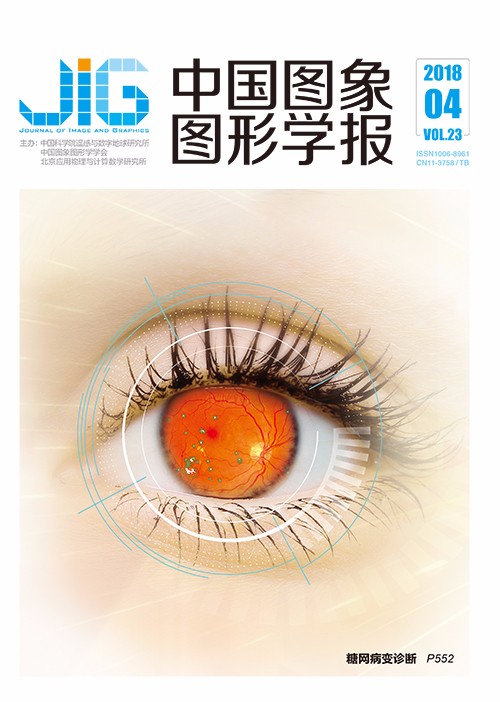
图像块的自适应均衡水印算法
摘 要
目的 针对水印算法通常利用实验确定强度参数,实验工作量大并且具有随机性,得到的参数无法较好地均衡水印不可见性和鲁棒性,提出一种基于图像块的自适应均衡水印算法。方法 利用尺度不变特征变换(SIFT)提取原始图像中鲁棒性强的特征点作为水印嵌入区域,将提取的嵌入区域分成4个大小相等且互不重叠的图像块,并对各图像块进行奇异值分解(SVD),得到与各块相应的奇异值矩阵,各块与水印做一级离散小波变换后产生的各子带相叠加,生成嵌入加密水印块,重组得到水印矩阵,降维后将特征点还原到原始图像。根据果蝇优化算法(FOA)中适应度函数迭代确定加密水印强度参数,构造水印图像的自适应嵌入,来均衡水印的不可见性和鲁棒性,水印检测可直接作用在受攻击后的图像上,无需校正恢复。结果 对标准灰度图像进行多组实验,得到含水印图像峰值信噪比均达到43dB以上;对水印载体图像分别进行噪声、压缩、剪切、旋转仿真攻击实验,提取水印图像与原始水印图像的归一化相关系数都达到0.94以上。结论 SIFT算法实现图像块局部嵌入,提取特征点稳定性强,结合SVD算法使水印嵌入性能良好,利用FOA算法自适应确定最优参数,使水印图像嵌入效果达到最佳状态,最终均衡了水印的不可见性和鲁棒性。
关键词
Watermarking algorithm for adaptive equalization based on image block
Qi Xiangming, Li Yue, Gao Ting, Zheng Ze(College of Software, Liaoning Technical University, Huludao 125105, China) Abstract
Objective Watermarking algorithm experiments are usually used as a standard to determine intensity parameters. However, the experimental workload is considerable and stochastic. A watermark is embedded in the original image to coordinate invisibility and robustness. The watermarked image has good invisibility but reduces the watermark robustness. A good watermark hiding technology must consider both the invisibility of the watermarked image and the robustness of the watermark and can resist various common attacks at the same time. An adaptive watermarking algorithm based on image block is proposed to balance invisibility and robustness. Method Scale-invariant feature transform (SIFT) is utilized to extract the original image with a robustness feature as good that of the watermark-embedded area. Before the embedding operation, feature points are filtered to eliminate the points with low contrast and edge point, and the resulting feature points have high stability. Two watermarking experiments with different watermark sizes are conducted. The extraction of the number of feature points is positively correlated with watermark size. When the watermark is extracted, the points are used again to locate the watermark. The feature points of the original carrier image are extracted to form a matrix with the same size as that of the watermarked image. The extracted embedded region is divided into four equal and non-overlapping image blocks. Each image block is decomposed by singular value decomposition (SVD) to obtain two orthogonal matrices U and V and a diagonal matrix S. Matrix S is superimposed by the subband of the first-class discrete wavelet transform of the watermark, which is embedded in the encrypted watermark. The watermark matrix is reorganized, and then the feature points are restored to the original image. The size of the embedded strength affects the performance of the extracted watermark. If the embedding intensity is defined as a constant, then it cannot be applied to each experiment type. Random values are also affected by the embedding effect of the watermark. The fitness function of the fruit fly optimization algorithm (FOA) is used in adaptive embedding of a watermark image. The senses of smell and sight of fruit flies are superior to those of other species. When flies recognize the smell of food, they fly in the direction of a target or partner. The FOA simulates this behavior. Two sets of watermarks with different sizes are embedded in this study. Two groups of objective function are selected through several experiments to determine the watermark embedding strength and to achieve a good embedding effect. The FOA is used to balance the invisibility and robustness of the watermark. The watermark detection can directly affect images after attacks without correction. Result Multi-standard experiments are conducted on standard gray images. Standard gray images of Lena, Baboon, and Plane are selected as the original images, and two binary images of "word" and "Liaoning Technical University" are used as watermark images. Peak signal-to-noise ratio (PSNR) is used to measure the imperceptibility of the watermark. A high PSNR indicates high imperceptibility. Normalized correlation coefficient (NC) is adopted to evaluate the similarity between the original and extracted watermarks. A large NC value means high robustness of the watermark. For a 16×16 watermark image, the optimal embedding intensities of the three gray images, Lena, Baboon, and Plane, are 0.302 7, 0.349 6, and 0.377 3, respectively. The PSNR of the watermarked image is above 45 dB. For a 32×32 watermark image, the optimal embedding intensities of the three gray images, Lena, Baboon, and Plane, are 0.240 1, 0.251 1, and 0.217 6, respectively. The PSNR of the watermarked image is above 43 dB. These values show that the algorithm achieves good invisibility. When the algorithm is not attacked, the extracted watermark images have NC values above 0.99, and the watermark robustness is high. External attacks should be resisted. The three gray images with watermark are simulated by applying noise, compression, shear, and rotation. The 16×16 watermark image under different attacks presents watermark NC values above 0.94. The attacks exert minimal influences on the quality of watermark extraction. The rotation, translation, and other geometric attacks on the 16×16 watermark image lead to NC values below 1. The watermark image loses some pixels in the rotation and translation processes. Therefore, in the process of watermark extraction, all pixels cannot be extracted, thereby resulting in an incomplete watermark. For compression attacks, the resulting NC values increase as the attack parameters increase. In the noise attack, the NC values of watermark obtained under different intensity attacks can reach more than 0.98, which shows that the algorithm has a great advantage in resisting noise attack. The embedding of the 32×32 watermark image exhibits a similar watermark effect when attacked by the same attacks, and the general trend of NC values under attacks is the same. The two groups of attack experiments show watermark NC values greater than 0.94, which indicates that the algorithm can effectively resist some bad attacks. Conclusion The feature points extracted by SIFT have a certain stability, and the local characteristics of watermarked images are affected by various geometric attacks, such as rotation and shear. The location of a watermark embedded in the algorithm is a part of the feature points extracted from the original image and is scattered. As a result, the watermark is not visually significant. SIFT is adopted to realize locally embedded image blocks. The SVD algorithm optimizes the watermarkembedding performance to extract stable feature points. The FOA allows each experiment group to yield adaptive intensity parameters and achieve the best embedding effect without the need to compare the parameters. This algorithm intelligently searches for optimal solutions that balance the invisibility and robustness of watermarks.
Keywords
adaptive watermarking scale invariant feature transform(SIFT) singular value decomposition(SVD) discrete wavelet transform(DWT) fruit fly optimization algorithm(FOA) self-adaption
|



 中国图象图形学报 │ 京ICP备05080539号-4 │ 本系统由
中国图象图形学报 │ 京ICP备05080539号-4 │ 本系统由